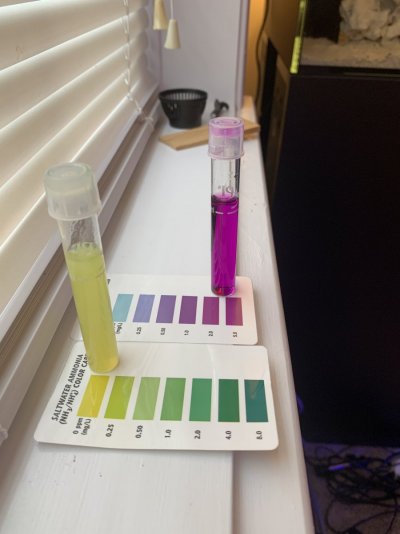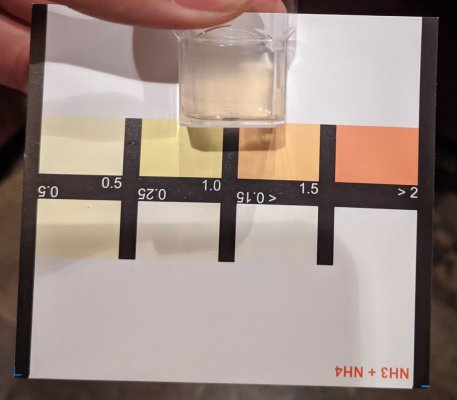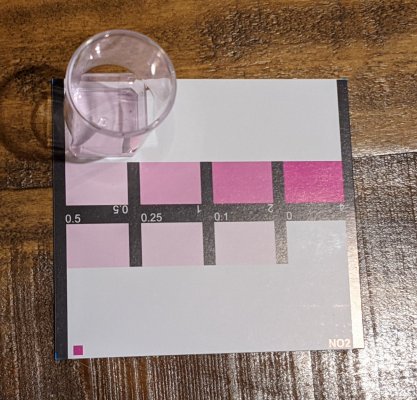Thanks for the input, I think I will just wait and see how day 20-30 go for now as I am just about to get fish in QT observation so I am in no rush. Funny thing is I am going to use Biospira to set up the QT.thanks tons for posting
The issue with bottle bac directions is they don’t account for constant misreads, which is any cycling param not from a calibrated digital read.
we have no way to meet their directions with today’s tools
our angle here is that for the last twenty years the hobby decided to attribute bacteria as the weak ones and not the test kits...so forum cycles take 30-90 days and MACNA cycles were instantly ready for decades, to sell us products used to skip cycles
we use known wait times plus minor clues such as some nitrite, some nitrate, to prove added bacteria weren’t dead - those are active footprints for nitrification.
so for our thread what we’ve done is reference work threads that charted out bottle bac brands using accurate kits, setting known timelines for completion and by extension no bottle bac takes longer than a cycling chart shows to complete, they're all thirty days maximum duration to finish. Most brands of bottle bac are ready in three days, or sooner, it’s why fish-in cycling doesn’t kill fish the bottle bac is fairly good nowadays
At the end of any given cycle (a pre chosen time underwater, not a test kit reading) we change water, add life and begin without consulting the test kits. Our thread is unique in that we don’t believe their readings, they are only approximations.
if you are in doubt of where the cycle is, simply let the current mix stew and in thirty days (you are already ten days wait) change for new water. If you have rocks and sand then it’s all cycled, and cannot fail to be. For anyone, cycles don’t fail to complete on at least this date.
this particular brand has been taking close to thirty days anyway to reliably move ammonia when people ran the three part ammonia test from page one. You can easily run that method on the ammonia kit (a series of three pictures) on a suspected completion date, or you can just ride out the current mix to day thirty and change water, you’ll be done regardless of what any kit says.
if you want to make use of purchases/bottle bac that allows a faster start than 30 days then the calibrated ammonia test from page one is the only way we know to make the ammonia kits work, to show the up/down motion. The brands of fritz, biospira and dr Tims are known to be ready in a few days after dosing, that fast they’re stuck to all surfaces per Dr. Reefs bottle bac comparison thread. This brand here you are using works, but it’s slowest
If you waited till day twenty total and changed water, I’m certain you can begin and that your test kits are likely to indicate a stall, as a misreport. So if we were taking your new reef to MACNA using that exact combo, we‘d pre cycle rocks for twenty days, to be ready on start date, some nitrate will prove your bottle was active vs killed mix, and we wouldn’t use the tests further we’d use twenty days duration as the closure. Plus big water change.
That’s how we make a dry start reef ready on time for MACNA, we could start twenty days early then we just move wet rocks up there and back home without using the tests other than initial glance at nitrate to prove activity.
Navigation
Install the app
How to install the app on iOS
Follow along with the video below to see how to install our site as a web app on your home screen.
Note: This feature may not be available in some browsers.
More options
You are using an out of date browser. It may not display this or other websites correctly.
You should upgrade or use an alternative browser.
You should upgrade or use an alternative browser.
How to unstick any seemingly stuck cycle
- Thread starter brandon429
- Start date
- Tagged users None
I really like this aspect of cycling charts. That final reliability
I’ve never once in 20 yrs online tank forum work seen any mix fail to complete by day 30 though we have seen most tanks come down from a higher level to .25
we r all racing to see who can beat the 30 day mark the fastest, cuz it’s a digital fast world nowadays, nbd.
qt was such a nice pairing for success
nh3 control is the easy part, disease prevention is the real challenge pls update us as months go by so readers can see the life arc from a good cycle through good disease preps and the payoff
the fundamental detail we can apply to your system is that on day thirty it’s past ready, no doubt. Start date all set
whatever those tests show is a stewing mix of bacteria taking on surfaces, varying metabolites, and lag time in reporting ups and downs.
when it’s changed for all new or mostly new water, the waste water mix is out, the slicks remain, and we are off and reefing. And it will never take longer than that chart shows.
I’ve never once in 20 yrs online tank forum work seen any mix fail to complete by day 30 though we have seen most tanks come down from a higher level to .25
we r all racing to see who can beat the 30 day mark the fastest, cuz it’s a digital fast world nowadays, nbd.
qt was such a nice pairing for success
nh3 control is the easy part, disease prevention is the real challenge pls update us as months go by so readers can see the life arc from a good cycle through good disease preps and the payoff
the fundamental detail we can apply to your system is that on day thirty it’s past ready, no doubt. Start date all set
whatever those tests show is a stewing mix of bacteria taking on surfaces, varying metabolites, and lag time in reporting ups and downs.
when it’s changed for all new or mostly new water, the waste water mix is out, the slicks remain, and we are off and reefing. And it will never take longer than that chart shows.
- Joined
- Feb 8, 2017
- Messages
- 58
- Reaction score
- 44
My turn to chime in on my "stuck" cycle! I'm currently cycling a Waterbox with approximately 40 gallons of water 25lbs of dry marco rock and 10lbs of dry sand.
Salinity: 1.027
Temp: 78.0
I'm using Brightwell's Microbacter Dry Rock Bacteria Starter Kit and have followed the instructions to the letter. Below is a table and graph showing my cycle thus far. I'm using API for ammonia and nitrite and salifert for nitrate.

So, after reading this thread, my conclusion is that my tank is cycled. The tank has processed the dosed ammonia and is producing nitrate indicating that the cycle is active. I think my only concern is that the nitrite doesn't seem to even be on the color spectrum of API. However, after some research (http://reefkeeping.com/issues/2005-06/rhf/index.php) it really seems like it's very unlikely for nitrite to approach levels that are toxic within the typical marine aquarium.
Therefore, I'm assuming the recommended path forward is to change as much water as possible and begin to add livestock.
Thanks!
Salinity: 1.027
Temp: 78.0
I'm using Brightwell's Microbacter Dry Rock Bacteria Starter Kit and have followed the instructions to the letter. Below is a table and graph showing my cycle thus far. I'm using API for ammonia and nitrite and salifert for nitrate.
| Ammonia (ppm) | Nitrite (ppm) | Nitrate (ppm) | Notes | |
| Day 1 | 2.00 | 0.00 | N/A | |
| Day 2 | 2.00 | 0.00 | N/A | |
| Day 3 | 2.00 | 0.00 | N/A | |
| Day 4 | 1.75 | 0.15 | N/A | Dosed XLM |
| Day 5 | 1.00 | 0.25 | N/A | |
| Day 6 | 1.00 | 0.50 | N/A | Dosed XLM |
| Day 7 | 1.00 | 1.00 | 25.00 | |
| Day 8 | 0.75 | 1.50 | N/A | |
| Day 9 | 0.50 | 2.00 | 40.00 | |
| Day 10 | 0.35 | 3.00 | 50.00 | |
| Day 11 | 0.25 | 5.00 | N/A | nitrite off chart? |
| Day 12 | 0.00 | 5.00 | 75.00 | nitrite off chart? |
| Day 13 | 0.00 | 5.00 | 75.00 | nitrite off chart? |
So, after reading this thread, my conclusion is that my tank is cycled. The tank has processed the dosed ammonia and is producing nitrate indicating that the cycle is active. I think my only concern is that the nitrite doesn't seem to even be on the color spectrum of API. However, after some research (http://reefkeeping.com/issues/2005-06/rhf/index.php) it really seems like it's very unlikely for nitrite to approach levels that are toxic within the typical marine aquarium.
Therefore, I'm assuming the recommended path forward is to change as much water as possible and begin to add livestock.
Thanks!
thank you tons for posting for sure, we want this job and the follow up fish as proof of good vs bad call.
I have these follow up questions and yes on cursory view it looks ready/machinery in play but these were my concerns:
10-13 day jobs are usually fritz, dr tim's or biospira this one here has shown to take a month to move ammonia in the chemistry forum before.
I forgot how many days are on the bottle/actual directions, following their printed regimen how many days is Brightwell can you remind me
*also, in their packaging, is some of that doser actual ammonia meaning you earned that high initial rating and it truly came down, or is that initial rating how your ammonia kit blanks on this water + bottle bac
if you added a known ammonium chloride source above norm, meant to drive up bac feed, and then bac, and 13 days and got the trending ammonia down then yes Im solid locked in agreement
if you indeed added a source of ammonium chloride and its been a little over 10 days to motion, then I bet the bottle bac directions say somewhere around a week to ten days
am googling to see
I have these follow up questions and yes on cursory view it looks ready/machinery in play but these were my concerns:
10-13 day jobs are usually fritz, dr tim's or biospira this one here has shown to take a month to move ammonia in the chemistry forum before.
I forgot how many days are on the bottle/actual directions, following their printed regimen how many days is Brightwell can you remind me
*also, in their packaging, is some of that doser actual ammonia meaning you earned that high initial rating and it truly came down, or is that initial rating how your ammonia kit blanks on this water + bottle bac
if you added a known ammonium chloride source above norm, meant to drive up bac feed, and then bac, and 13 days and got the trending ammonia down then yes Im solid locked in agreement
if you indeed added a source of ammonium chloride and its been a little over 10 days to motion, then I bet the bottle bac directions say somewhere around a week to ten days
am googling to see
Last edited:
- Joined
- Feb 8, 2017
- Messages
- 58
- Reaction score
- 44
The brightwell kit quotes 7 days. The cycle instructions are below.
Cycling Instructions:
Day 1:
Day 3: Measure pH, Ammonia and Nitrite and record values.
Day 4: Measure pH, Ammonia and Nitrite. If either Ammonia or Nitrite are over .25 ppm, you can add more bacteria, if desired.
Day 5: Measure pH, Ammonia and Nitrite and record values
Day 6: Measure pH, Ammonia and Nitrite. If either Ammonia or Nitrite are over .25 ppm, you can add more bacteria, if desired.
Day 7:
Day 9 and subsequent days: Measure pH, Ammonia and Nitrite. If Ammonia & Nitrite values are zero, then measure nitrate and if there is a reading of Nitrate at .25 ppm or higher, then the aquarium is cycled.
To answer your remaining question. Yes the bottle of "ammonia" contains: water, ammonia, ammonium chloride, and "proprietary base".
My method was: dose the ammonia source to the tank, test ammonia (ammonia read ~2ppm as it should), dose the microbacter XLM bacteria to the tank as per the directions above.
Cycling Instructions:
Day 1:
- Turn off skimmer, UV and remove fine filtration such as socks.
- You must use a good dechlorinator first, such as Brightwell Erāse-CL to remove chloramine and chlorine! If using RODI water, you can skip this step.
- Prepare water and adjust salinity, and temperature.
- Add full dose of QuikCycl at 4 drops per gallon or 1 ml per 5 gallons of tank capacity.
- Measure Ammonia. It should be between 1 and 2 ppm total ammonia, which is ammonia plus ammonium (NH3 and NH4+). Do not add more to get the proper reading either today or throughout the days that follow. This is because the bacteria will quickly begin to use up the ammonia, and even though added, it will may not show up on your tests.
- Add MicrōBacter Start XLM, or MicrōBacter Start XLF as appropriate for your aquarium, as directed.
Day 3: Measure pH, Ammonia and Nitrite and record values.
Day 4: Measure pH, Ammonia and Nitrite. If either Ammonia or Nitrite are over .25 ppm, you can add more bacteria, if desired.
Day 5: Measure pH, Ammonia and Nitrite and record values
Day 6: Measure pH, Ammonia and Nitrite. If either Ammonia or Nitrite are over .25 ppm, you can add more bacteria, if desired.
Day 7:
- Measure pH, Ammonia and Nitrite and record values.
- If using MicrōBacter Start XLM, and your Ammonia and Nitrite show zero, then measure Nitrate. If Nitrate is showing .25 ppm or higher, then your aquarium is cycled. If using any other bacteria, then go to Day 8.
Day 9 and subsequent days: Measure pH, Ammonia and Nitrite. If Ammonia & Nitrite values are zero, then measure nitrate and if there is a reading of Nitrate at .25 ppm or higher, then the aquarium is cycled.
To answer your remaining question. Yes the bottle of "ammonia" contains: water, ammonia, ammonium chloride, and "proprietary base".
My method was: dose the ammonia source to the tank, test ammonia (ammonia read ~2ppm as it should), dose the microbacter XLM bacteria to the tank as per the directions above.
I have started about a half dozen tanks and I have never actually cycled any of them. I do big water changes for the first week. Half that the second week and then let it rip. Haven't failed yet but I could just be getting lucky.
If I had a "stuck" cycle, I would just crank up the water changes and put a fish in.
If I had a "stuck" cycle, I would just crank up the water changes and put a fish in.
Cameron I totally believe that to be the case. It makes use of the typically high ratio of water volume to bioload we use and simply exports any waste before its an issue, a cycling chart shows inherent basal ammonia control in ten days because anything living in the new system as a test has already imported filter bac stuck to it + the natural contaminations earned by setting up reefs in homes. It would take a small tank and high bioload or high level feeding to wreck things in that approach.
This typical ratio of large tank/tiny fish and dilution provides a buffer for us for times when someone’s bottle bac that may not be perfectly handled in shipping
thanks tons for posting
ajnies im impressed at their timeline and testing claims. My gosh that’s not terribly far off from what we are using here, and I thought this method was all rogue like zorro lol
they have an extremely sensible cycling method I can’t fault any of it. 100% agreed you are ready, if your added bioload dies in a cloudy smelly haze in two days then we did bad and w be accountable for update outcomes here, we think this science is dependable and that nobody’s tank will fail to meet safety especially with your multiple markers in place.
two solid posts here team, nice one.
This typical ratio of large tank/tiny fish and dilution provides a buffer for us for times when someone’s bottle bac that may not be perfectly handled in shipping
thanks tons for posting
ajnies im impressed at their timeline and testing claims. My gosh that’s not terribly far off from what we are using here, and I thought this method was all rogue like zorro lol
they have an extremely sensible cycling method I can’t fault any of it. 100% agreed you are ready, if your added bioload dies in a cloudy smelly haze in two days then we did bad and w be accountable for update outcomes here, we think this science is dependable and that nobody’s tank will fail to meet safety especially with your multiple markers in place.
two solid posts here team, nice one.
Last edited:
- Joined
- Feb 8, 2017
- Messages
- 58
- Reaction score
- 44
@brandon429 Thanks for the reply! I'd have to agree with you that the tank is likely cycled. The tricky part here is that I have a pair of 4 year old clowns coming from another tank. While I agree it's probably cycled, I have too much of an attachment to these fish to test it on them. I'm thinking a hermit/snail or two might be good pioneers after a 50% waterchange or two.Cameron I totally believe that to be the case. It makes use of the typically high ratio of water volume to bioload we use and simply exports any waste before its an issue, a cycling chart shows inherent basal ammonia control in ten days because anything living in the new system as a test has already imported filter bac stuck to it + the natural contaminations earned by setting up reefs in homes. It would take a small tank and high bioload or high level feeding to wreck things in that approach.
This typical ratio of large tank/tiny fish and dilution provides a buffer for us for times when someone’s bottle bac that may not be perfectly handled in shipping
thanks tons for posting
ajnies im impressed at their timeline and testing claims. My gosh that’s not terribly far off from what we are using here, and I thought this method was all rogue like zorro lol
they have an extremely sensible cycling method I can’t fault any of it. 100% agreed you are ready, if your added bioload dies in a cloudy smelly haze in two days then we did bad and w be accountable for update outcomes here, we think this science is dependable and that nobody’s tank will fail to meet safety especially with your multiple markers in place.
two solid posts here team, nice one.
I'll be sure to reply to the thread to let you know what I decide / how it goes.
Thanks!
Would you take a pic of your current ammonia reading as it runs now, I need the pic for another thread on api reads. Or red sea if that’s your measure
- Joined
- Feb 8, 2017
- Messages
- 58
- Reaction score
- 44
Will do. I'll try to post something this afternoon.Would you take a pic of your current ammonia reading as it runs now, I need the pic for another thread on api reads. Or red sea if that’s your measure
Interesting detail on the sub: that’s a tiny bioload, not much test I know a reader might be thinking, neither is a couple fish. A reef is a real bioload...
what you’re testing is lethality for any remaining ammonia. Anything that lives in the tank does so due to nh3 control, despite the low end reading
but the actual test / degree of bioload and feeding able to support is a function of two things: your degree of surface area used (rocks and sand) and whether or not we can trust filtration bacteria to adhere to the surfaces in this amount of time. Two reasons we can: you showed ammonia going down by the date on directions from a studied company, and the bac are by nature benthics who do attach. Dr Reefs bottle bac thread specifically used full water changes and redosing to prove readiness, that’s a measure of adherence not suspension bacteria. For comparison, here’s Dr Reefs posted zero on api and red sea but this isn’t from a dosed reef, it’s from clean water unused
as blanks:

red sea

we think tests ran on actual cycled reefs will over report natural conversion rates. Clean water has no nitrification to over report. Seabass on nano-reef.com called that about eight years ago, she was right apparently. My other thread is a collection of post cycle reef ammonia reads.
what you’re testing is lethality for any remaining ammonia. Anything that lives in the tank does so due to nh3 control, despite the low end reading
but the actual test / degree of bioload and feeding able to support is a function of two things: your degree of surface area used (rocks and sand) and whether or not we can trust filtration bacteria to adhere to the surfaces in this amount of time. Two reasons we can: you showed ammonia going down by the date on directions from a studied company, and the bac are by nature benthics who do attach. Dr Reefs bottle bac thread specifically used full water changes and redosing to prove readiness, that’s a measure of adherence not suspension bacteria. For comparison, here’s Dr Reefs posted zero on api and red sea but this isn’t from a dosed reef, it’s from clean water unused
as blanks:
red sea
we think tests ran on actual cycled reefs will over report natural conversion rates. Clean water has no nitrification to over report. Seabass on nano-reef.com called that about eight years ago, she was right apparently. My other thread is a collection of post cycle reef ammonia reads.
Last edited:
Ok as requested by @brandon429; I'll post my cycle progress so far. Used locally sourced seawater to fill from an area known to be pollutant free (based on council water sampling). Same water used for water changes in my nano reef for the last year with no issues. suspected organics leaching from old live rock. Waterbox 90.3, old live rock, dry sand.
Will update this post as I go.
| NH3 | N02 | N03 | Notes | ||
| Day 1 | 0 | 0 | 0 | ghost feed | Dosed Fluval Bacteria |
| Day 2 | Did not test | ghost feed | Dosed Fluval Bacteria | ||
| Day 3 | 2 | 0 | 0 | Dosed API Bacteria | |
| Day 4 | 2 | 0 | 0 | ||
| Day 5 | |||||
| Day 6 | |||||
| Day 7 | |||||
| Day 8 | |||||
| Day 9 | |||||
| Day 10 |
Will update this post as I go.
OK can't edit my last post. Delete it if you can.
Tested again. Seems the cycle may have started. I find the nitrate colouration hard to match but my wife, who is a chemist, is pretty certain it's 5 ppm.
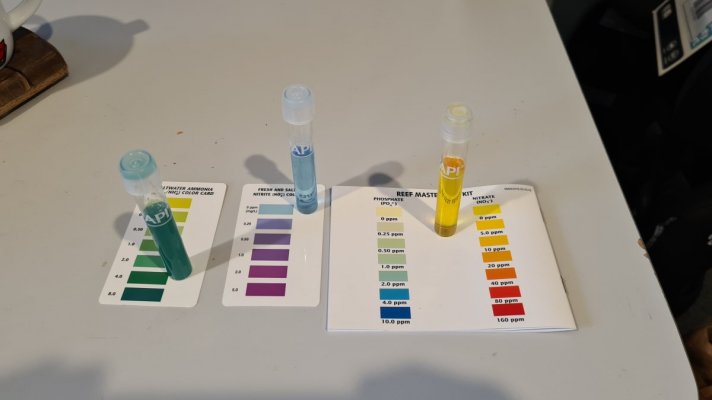
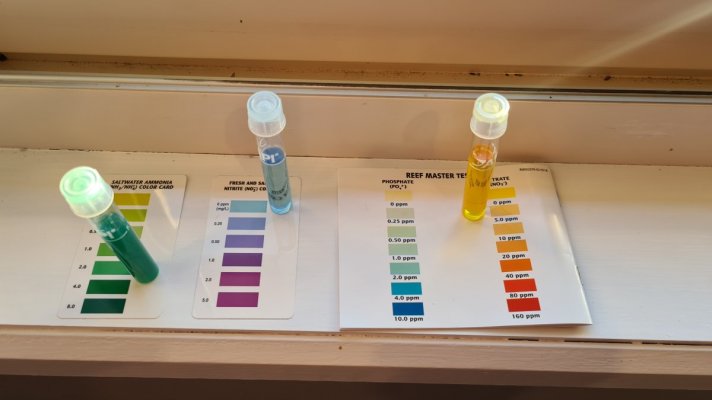
Tested again. Seems the cycle may have started. I find the nitrate colouration hard to match but my wife, who is a chemist, is pretty certain it's 5 ppm.
| NH2 | N02 | N03 | Notes | ||
| Day 1 | 0 | 0 | 0 | ghost feed | Dosed Fluval Bacteria |
| Day 2 | Did not test | ghost feed | Dosed Fluval Bacteria | ||
| Day 3 | 2 | 0 | 0 | Dosed API Bacteria | |
| Day 4 | 2 | 0 | 0 | ||
| Day 5 | 3-4 | 0 | 5 | added locally invasive porcelain crab to sump | |
| Day 6 | |||||
| Day 7 | |||||
| Day 8 | |||||
| Day 9 | |||||
| Day 10 |


LgTas is doing wonderfully here. He has access to myriad small ocean creatures at his front door, and he’s met all the timing rules from our thread, and the menagerie of life added still keeps living in clear water-no smell, but api still doesn’t agree fully on the ammonia (shocking). This cycle has moved along nicely.

 www.reef2reef.com
www.reef2reef.com

Cannot jump start cycle
I'm struggling to get my cycle started. Set up my Waterbox 90.3 5 days ago using old live rock, dry washed sand, and locally sourced seawater (pollutant and nutrient free). I've cut and paste the blurb from my build thread as it seems no one is really reading it (hence starting a focused...
 www.reef2reef.com
www.reef2reef.com
- Joined
- Jan 20, 2017
- Messages
- 60
- Reaction score
- 12
I'll throw in my "stalled cycle" for discussion.
I have a new 400 gallon tank with 120 lbs of reef flakes and 200+ lbs of Caribsea Life Rock. 3.5 weeks ago I added enough ammonium chloride to test to 2 ppm on API test kit. Since that time I've seen no real movement on ammonia reading - still higher than 1.0 ppm and closer to 2.0 ppm. I was initially waiting for ammonia to drop to test nitrite, but I may run to get a nitrite test kit today to see where that sits. Any thoughts on this situation?
I have a new 400 gallon tank with 120 lbs of reef flakes and 200+ lbs of Caribsea Life Rock. 3.5 weeks ago I added enough ammonium chloride to test to 2 ppm on API test kit. Since that time I've seen no real movement on ammonia reading - still higher than 1.0 ppm and closer to 2.0 ppm. I was initially waiting for ammonia to drop to test nitrite, but I may run to get a nitrite test kit today to see where that sits. Any thoughts on this situation?
We are 99% done on that one due to 3.5 weeks wait, last question is what brand of bottle bac used so we know the completion date for the strain used
*if none used, only feeding and natural inputs for bacteria then if you can change water or use purigen to get ammonia back down we think a cycling chart applies and there’s a basal layer of bacteria ready. The degree of ammonia added far exceeds a basic starting bioload, thats why after a water change the system can support life and it can explain why you don’t see movement.
we track several threads where api or Red Sea holds a reading in place long after its fixed, if the water smells normal right now vs light smell of kitty litter / 2 ppm stinks a little/ that’s a helpful side indicator of motion.
not saying this happens in all testing but it happens
posted recently by Burt M
Update for everyone. The API test kit for ammonia and nitrite are awful. At day 4 it was still reading >8ppm and 0ppm for ammonia and nitrite respectively. Salifert test kits arrived today and ammonia is between 1-1.5ppm, nitrite is 0.5ppm. Going to toss those API tests. Thanks for the input, everything is going smoothly.
*if none used, only feeding and natural inputs for bacteria then if you can change water or use purigen to get ammonia back down we think a cycling chart applies and there’s a basal layer of bacteria ready. The degree of ammonia added far exceeds a basic starting bioload, thats why after a water change the system can support life and it can explain why you don’t see movement.
we track several threads where api or Red Sea holds a reading in place long after its fixed, if the water smells normal right now vs light smell of kitty litter / 2 ppm stinks a little/ that’s a helpful side indicator of motion.
not saying this happens in all testing but it happens
posted recently by Burt M
Update for everyone. The API test kit for ammonia and nitrite are awful. At day 4 it was still reading >8ppm and 0ppm for ammonia and nitrite respectively. Salifert test kits arrived today and ammonia is between 1-1.5ppm, nitrite is 0.5ppm. Going to toss those API tests. Thanks for the input, everything is going smoothly.
Attachments
- Joined
- Jan 20, 2017
- Messages
- 60
- Reaction score
- 12
Sorry - yeah I added two bottles of Dr. Tims for the cycle. I suppose that was a key point I omitted...
Similar threads
- Replies
- 12
- Views
- 198
- Replies
- 1
- Views
- 44
- Replies
- 10
- Views
- 245
- Replies
- 8
- Views
- 107








